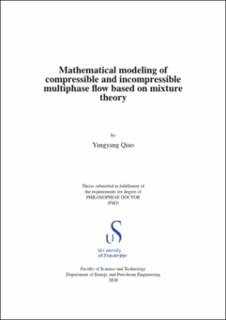| dc.contributor.author | Qiao, Yangyang | |
| dc.date.accessioned | 2021-11-01T09:55:13Z | |
| dc.date.available | 2021-11-01T09:55:13Z | |
| dc.date.issued | 2020-11 | |
| dc.identifier.citation | Mathematical modeling of compressible and incompressible multiphase flow based on mixture theory by Yangyang Qiao, Stavanger : University of Stavanger, 2021 (PhD thesis UiS, no. 501) | en_US |
| dc.identifier.isbn | 978-82-7644-904-4 | |
| dc.identifier.issn | 1890-1387 | |
| dc.identifier.uri | https://hdl.handle.net/11250/2826775 | |
| dc.description.abstract | MIXTURE THEORY has been developed based on balance laws and conservation principles which is well known in continuum mechanics, and has been widely applied to systems which can be characterized as a mixture of interacting continua. In this thesis we present a general mathematical model for the compressible and incompressible multiphase flows based on the theory of mixtures and investigate the corresponding numerical schemes that are used to solve different kinds of flow phenomena. Mathematical analysis, which essentially boils down to deriving various estimates in appropriate functional spaces, is also used as a tool to gain insight into the models that have been explored.
The first part (Paper I and II) of this thesis implements a novel two-phase momentum-equation-approach to include the viscous coupling effect involved in counter-current and co-current flows during spontaneous imbibition process for oil recovery. The formulation can automatically capture the effective relative permeabilities of the flowing phases and offers improvements over conventional modelling. The model also accounts for the fact that oil must overcome the so-called capillary backpressure when it is produced counter-currently. It is shown that this parameter can influence the extent of counter-current production and hence viscous coupling.
The second part (i.e., Paper III-V) of this thesis focuses on the development of numerical schemes for solving the general multiphase flow model. We consider two-phase and three-phase flow in porous media for both incompressible and compressible cases. We also explore in Paper III and IV different estimates that can deepen the insight into the system which is studied as well as ensure existence of solutions subject to appropriate assumptions. Specifically, in Paper III, a general two-phase model without source terms is solved and the investigations indicate that interstitial velocity seems more natural to use in the viscous term than Darcy velocity for the momentum balance equation. In Paper IV, source terms are taken into account and different physical effects are highlighted such as compressibility and viscous coupling. Various a priori estimates are derived that give rise to an existence result for the general two-phase model with and without source terms. In addition, we also extended the two-phase model to the three-phase model in Paper V and illustrated the stability of the developed numerical schemes by investigating several numerical examples, both for the case with incompressible and compressible fluids.
In the last part of this thesis, represented by Paper VI, we explore a general cell-fluid Navier-Stokes model to mimic an evolution process of the bacterial plumes development. The generality of the mixture theory approach allows us to incorporate a new migration effect, so-called chemotaxis, in the momentum balance for the cell phase. Chemotaxis and gravity segregation are two main driving forces that result in a complex flow pattern formation of bacterial. The nonlinear dynamics is explored in a 2D setting by using an appropriate finite difference scheme. This model can be interpreted as a generalization of the well-known chemotaxis-Stokes model which has attracted much attention the last decade. | en_US |
| dc.language.iso | eng | en_US |
| dc.publisher | Stavanger, University of Stavanger | en_US |
| dc.relation.ispartofseries | PhD thesis UiS;501 | |
| dc.relation.haspart | Paper 1: Qiao, Yangyang, Andersen, Pål Østebø, Evje, Steinar and Standnes, Dag Chun. ’A mixture Theory Approach to Model Co- and Counter-current Two-phase Flow in Porous Media Accounting for Viscous Coupling’. In: Advances in Water Resources, 112 pp.170-188 (2018). | en_US |
| dc.relation.haspart | Paper 2: Andersen, Pål Østebø, Qiao, Yangyang, Standnes, Dag Chun and Evje, Steinar. ’Cocurrent Spontaneous Imbibition in Porous Media with the Dynamics of Viscous Coupling and Capillary Backpressure’. In: SPE Journal, 24 pp.158-177 (2019). This paper is not available in Brage due to copyright. | en_US |
| dc.relation.haspart | Paper 3: Qiao, Yangyang, Wen, Huanyao and Evje, Steinar. ’Compressible and Viscous Two-phase Flow in Porous Media Based on Mixture Theory Formulation’. In: Networks and Heterogeneous Media, 14 (3) pp.489-536 (2019). | en_US |
| dc.relation.haspart | Paper 4: Qiao, Yangyang, Wen, Huanyao and Evje, Steinar. ’Viscous Two-phase Flow in Porous Media Driven by Source Terms: Analysis and Numerics’. In: SIAM Journal on Mathematical Analysis, 51 (6) pp.5103-5140 (2019). | en_US |
| dc.relation.haspart | Paper 5: Qiao, Yangyang and Evje, Steinar. ’A Compressible Viscous Three-phase Model for Porous Media Flow Based on the Theory of Mixtures’. Under review in: Advances in Water Resources. | en_US |
| dc.relation.haspart | Paper 6: Qiao, Yangyang and Evje, Steinar. ’A General Cell-fluid Navier-Stokes Model with Inclusion of Chemotaxis’. Accepted in: Mathematical Models and Methods in Applied Sciences. [doi: 10.3934/nhm.2019020] | en_US |
| dc.subject | petroleumsteknologi | en_US |
| dc.subject | matematisk modellering | en_US |
| dc.title | Mathematical modeling of compressible and incompressible multiphase flow based on mixture theory | en_US |
| dc.type | Doctoral thesis | en_US |
| dc.rights.holder | © 2020 Yangyang Qiao | en_US |
| dc.subject.nsi | VDP::Teknologi: 500::Berg‑ og petroleumsfag: 510::Petroleumsteknologi: 512 | en_US |
| dc.subject.nsi | VDP::Matematikk og Naturvitenskap: 400::Matematikk: 410 | en_US |
